As the sun set at The New Mart downtown, the Los Angeles Asian Fashion Week runway turned dark, and audiences focused on the video projected on the wall, reading out “Stop Asian Hate.” A model in a black fur coat and a lace ski mask came out, standing tall against the words “Love Every Color,” while the audience thunderously cheered.
LAAFW aims to give a platform for Asian American designers and models to share their culture, according to its online portfolio. For its third annual fashion show, LAAFW raised money for “Angels for Street Kids,” a charity program that feeds children living on the streets in the Philippines.
“It may be Asian Fashion Week, but tonight is not just about fashion,” Jules Graeser, one of the event’s hosts, said, “Tonight is also about beauty and talent and representing the very best of our community.”
The event opened with a countdown on the wall as the lights dimmed. Models strutted out in bright red leather, towering headwear and rows of glitter, giving a preview of the night’s looks.
LAAFW is split into two shows: one afternoon show for young designers and children’s fashion, and an evening show for more established designers from Asia.
The afternoon show started with a small contest, wherein children, teens and young adults compete to be LAAFW’s top models in their respective categories. No matter their age, contestants posed for audiences with the level of professionalism and poise of established models.
“I think we need this representation,” Jet Sison, one of the judges of the model show, said. “Most of us are in healthcare, most of us are engineers or doctors, but to be [included] in fashion is refreshing.”
The first designer, Jesse J Collections, featured looks reminiscent of his celebrity styling days. These looks use the classic silhouettes, like the three-piece suit, mixed with bold elements, like satin and gold buttons. His line gives the impression that anyone in these curated pieces can become a star, cementing his expertise in the world of celebrity fashion.
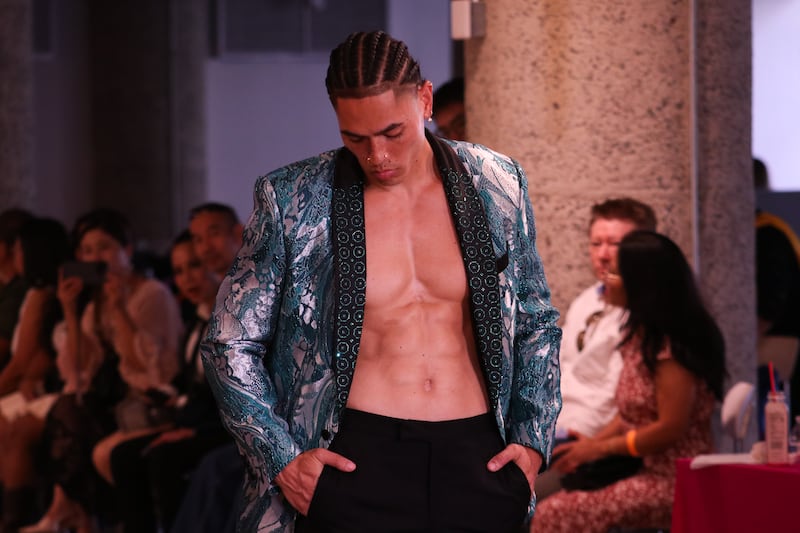
Charlie Designs followed with a line of children’s and adult fashion, showing how sophisticated, exciting fashion has no age. Their younger models were styled in timeless cocktail party designs, walking the stage in embroidered shawls and sequined, bodycon dresses.
Even with the more sophisticated silhouettes, Charlie Designs also infused more playful elements in both their child and adult looks, styling some of the dresses with sneakers instead of black pumps. A standout in this line was a blue bodycon dress and cape, which was juxtaposed by converse-style high heels.
Then came designer Eric Gleenie’s line, which focused on redesigning the typical suit and tie. His designs appeared seemingly simple until it became noticeable that the suits and ties were both half white and black, not one color.
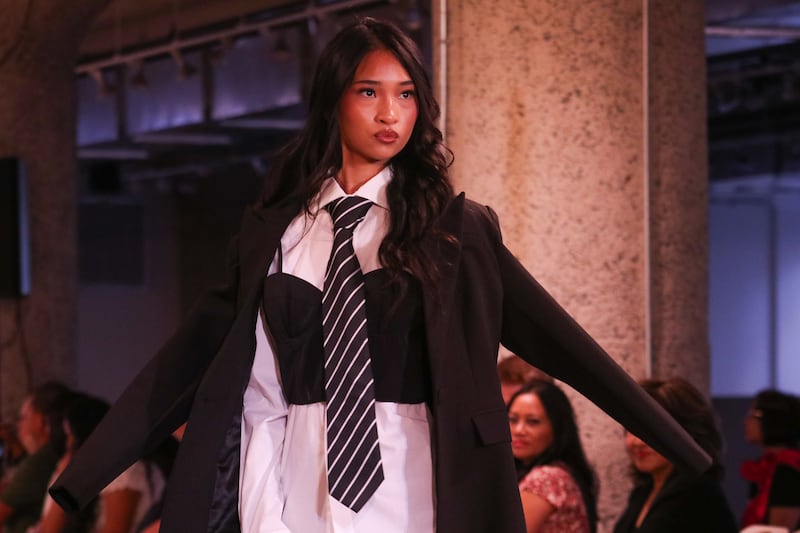
Gleenie’s designs continued down the runway, adding pops of color to the formal suit, until models came out in hot pink sets and gogo boots. The line ended with letterman jackets in place of the suit jacket, and a tie to match, showing how this designer was all about experimenting with the classics.
The afternoon show ended with a line to remember, as designer Kiki Wang unveiled children’s and women’s dresses straight from a fairytale. The dresses ranged from contemporary slips with tasteful hints of rosettes, to full ball gowns finished with a train of sequins. Each model walked out in a matching tiara, embellished with jewels that sparkled in the light.
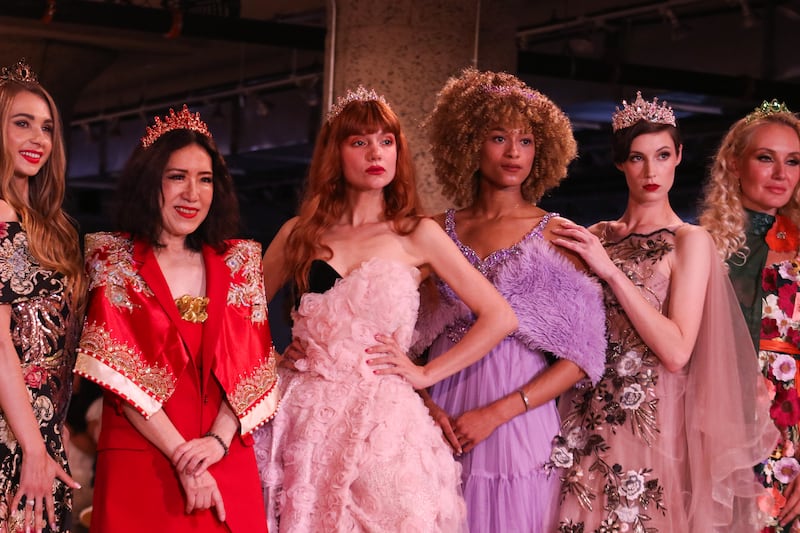
As a Chinese designer, Wang also incorporated modernized East Asian elements in her work. One of her dresses featured a Chinese cloud collar, but with embroidery done in sequins rather than traditional black satin ribbon and brocade. Another dress also included a tassel pendant, reminiscent of accessories that sometimes adorn the Chinese Hanfu dress and the Korean Hanbok.
Thai designer brand, The Phukaw, began the evening show, not with a line of models, but with a traditional Thai dance. The dancers themselves wore the Chakri (a type of traditional Thai dress) coupled with intricately carved gold accents and flowers trailing down their hair, emphasizing the unique fashion within Thai culture.
The Phukaw collection ranged from the traditional to the experimental. The line first introduced audiences to cross-body gold jewelry, gold nail claws and Kohn masks once used in Thai masked dance dramas. The designs then evolved into one-of-a-kind evening wear, as The Phukaw combined elements of burlesque and pageant fashion with iconic Thai elements. Models were styled in fur boas, satin and sequin dresses, black jeweled arm cuffs and Thai Makuta headdresses topped with feathers, closing the line with silhouettes to remember.
Filipino designer Edwin Uy followed suit, styling his models with weapons along with the typical platform heel. Dressed in pre-colonial Filipino-inspired beadwork, models charged down the runway with their swords and shields, ready for battle.
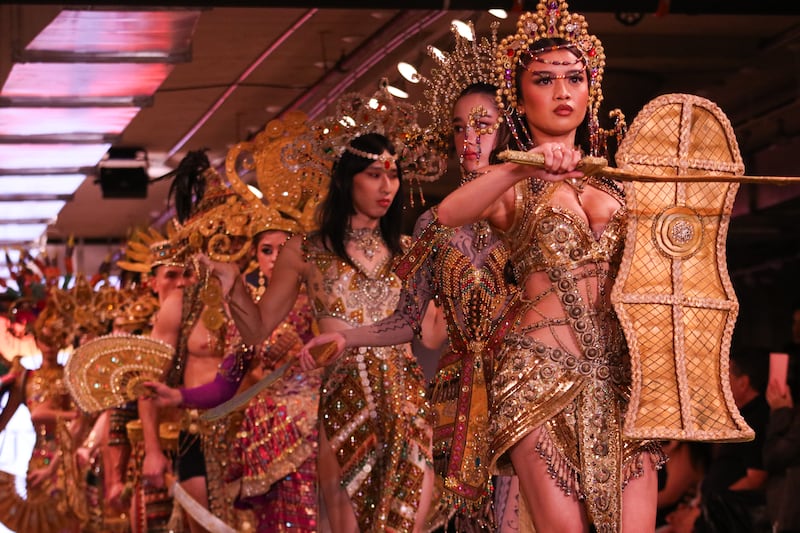
A woman with fiery, multicolored wings stood proud before the warriors, reminiscent of how birds in Filipino literature were often depicted as powerful beings. Like The Phukaw, Uy displayed the importance of fashion in remembering ancient Filipino heritage.
Uy continued the legacy of Filipino traditions, as he showcased his redefinition of the Barong, or traditional Filipino menswear. His version of the Barong kept the detailed stitchwork but featured bold, geometric patterns in contrast to the traditional off-white base. The male models were also styled in couture rice farmer hats, rimmed with intricate beadwork, in line with Uy’s brand.
Jean Amour, also a Filipino designer, had her models walk the stage in big and bold pieces. Amour specializes in exaggerated silhouettes, featuring dresses with Filipiniana (Filipino womenswear) style butterfly sleeves and an Elizabethan whisk collar. Amour ended her line with a model in angel wings as tall as her, wearing a lace mask that accentuated the eccentricity of the designer’s motif.
The mood shifts as Filipino designer Katniss Griffiths introduces an all-grunge line for women. Her style asserts itself in the stylized corsets, fishnet detailing and handmade headdresses adorned with gears and chess pieces. With her distinct approach, Griffiths builds a world of retrofuturism and mystery that sucks audiences in.
Kiel Ortega closed LAAFW with a line that took an unconventional approach to what is deemed “sexy.” Ortega played with the limits of silhouette, cropping suit jackets until they only reached the shoulders, and creating gravity-defying diamond arches in place of shoulder pads. A standout in this collection is one of his models wearing a dress with tulle sleeves draped over a sleek bodysuit, accented by the diamond-crested sword she carried.
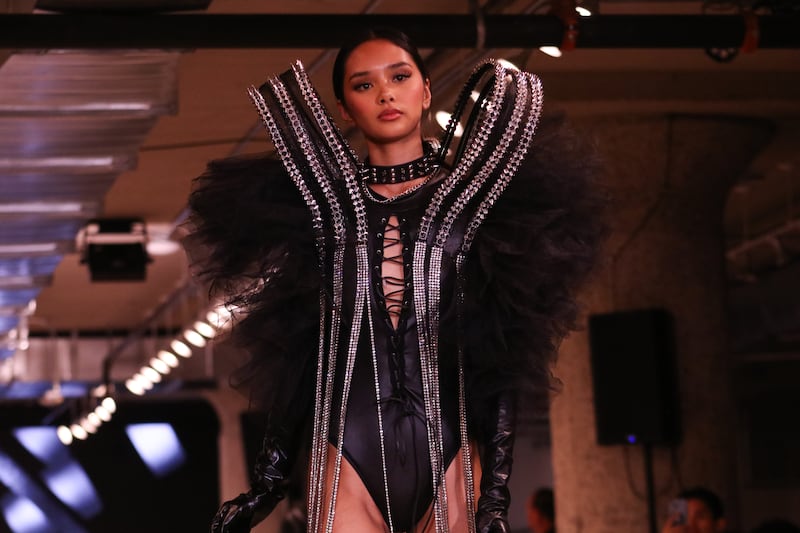
After the show, Griffiths said she was excited to be part of a show that promoted Asian representation and reflected on how hard she and her team worked to prepare for the event. She said her models would follow her from all over the world — New York, Japan and more — to be part of the show. Griffiths said she stayed up most nights until 2 a.m.creating headpieces and feeling proud once she finally saw her models on stage with it on.
“I’m so proud to see that it’s not just Asians that are here,” Griffiths said. “It’s good recognition, not just for Filipinos, but for different nationalities.”
